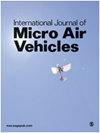A design framework for realizing multifunctional wings for flapping wing air vehicles using solar cells
IF 1.6
4区 工程技术
Q2 ENGINEERING, AEROSPACE
引用次数: 7
Abstract
Long flight durations are highly desirable to expand mission capabilities for unmanned air systems and autonomous applications in particular. Flapping wing aerial vehicles are unmanned air system platforms offering several performance advantages over fixed wing and rotorcraft platforms, but are unable to reach comparable flight times when powered by batteries. One solution to this problem has been to integrate energy harvesting technologies in components, such as wings. To this end, a framework for designing flapping wing aerial vehicle using multifunctional wings using solar cells is described. This framework consists of: (1) modeling solar energy harvesting while flying, (2) determining the number of solar cells that meet flight power requirements, and (3) determining appropriate locations to accommodate the desired number of solar cells. A system model for flapping flight was also developed to predict payload capacity for carrying batteries to provide energy only for power spikes and to enable time-to-land safely in an area where batteries can recharge when the sun sets. The design framework was applied to a case study using flexible high-efficiency (>24%) solar cells on a flapping wing aerial vehicle platform, known as Robo Raven IIIv5, with the caveat that a powertrain with 81% efficiency is used in place of the current servos. A key finding was the fraction of solar flux incident on the wings during flapping was 0.63 at the lowest solar altitude. Using a 1.25 safety factor, the lowest value for the purposes of design will be 0.51. Wind tunnel measurements and aerodynamic modeling of the platform determined integrating solar cells in the wings resulted in a loss of thrust and greater drag, but the resulting payload capacity was unaffected because of a higher lift coefficient. A time-to-land of 2500 s was predicted, and the flight capability of the platform was validated in a netted test facility.利用太阳能电池实现扑翼飞行器多功能机翼的设计框架
长时间的飞行是非常理想的,以扩大任务能力的无人机系统和自主应用,特别是。扑翼飞行器是一种无人驾驶的空中系统平台,与固定翼和旋翼飞机平台相比,它具有多种性能优势,但在电池供电时无法达到可比的飞行时间。解决这个问题的一种方法是将能量收集技术集成到部件中,比如机翼。为此,提出了一种基于太阳能电池的多功能机翼扑翼飞行器的设计框架。该框架包括:(1)模拟飞行时的太阳能收集,(2)确定满足飞行功率要求的太阳能电池数量,以及(3)确定适当的位置以容纳所需数量的太阳能电池。还开发了一个扑翼飞行的系统模型,以预测携带电池的有效载荷能力,仅为功率峰值提供能量,并确保在太阳下山时电池可以充电的区域安全着陆。该设计框架被应用于一个案例研究中,该案例研究使用柔性高效太阳能电池(>24%)安装在扑翼飞行器平台上,该平台被称为Robo Raven IIIv5,需要注意的是,该平台采用了81%效率的动力系统来取代目前的伺服系统。一个关键的发现是,在最低太阳高度,扑动过程中入射到机翼上的太阳通量的比例为0.63。使用1.25的安全系数,设计的最低值为0.51。风洞测量和平台的空气动力学建模表明,在机翼中集成太阳能电池会导致推力损失和更大的阻力,但由于升力系数更高,因此有效载荷能力不受影响。预计着陆时间为2500s,并在网状试验设施中验证了该平台的飞行能力。
本文章由计算机程序翻译,如有差异,请以英文原文为准。
求助全文
约1分钟内获得全文
求助全文
来源期刊

International Journal of Micro Air Vehicles
ENGINEERING, AEROSPACE-
CiteScore
3.00
自引率
7.10%
发文量
13
审稿时长
>12 weeks
期刊介绍:
The role of the International Journal of Micro Air Vehicles is to provide the scientific and engineering community with a peer-reviewed open access journal dedicated to publishing high-quality technical articles summarizing both fundamental and applied research in the area of micro air vehicles.
 求助内容:
求助内容: 应助结果提醒方式:
应助结果提醒方式:


